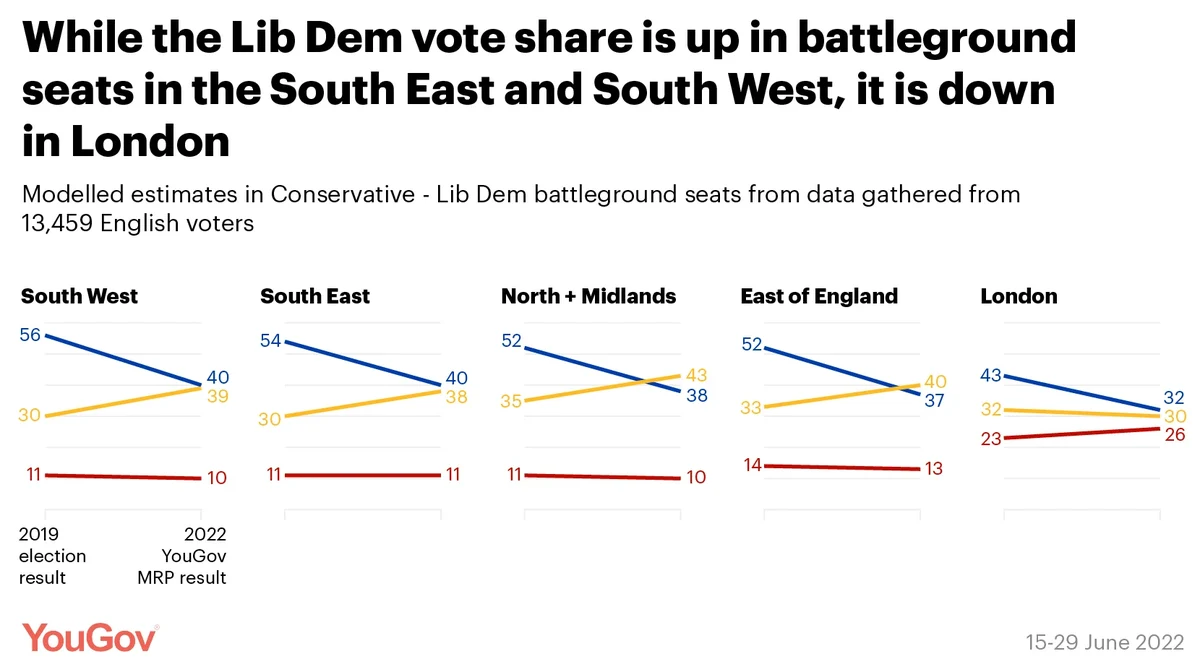New YouGov MRP poll suggests Dominic Raab and Jeremy Hunt would lose their seats if an election were being held now
Last Thursday the Liberal Democrats overturned a huge Conservative majority to comfortably win a by-election contest for the third time this parliament.
Following notable wins in both Chesham and Amersham and North Shropshire, the Liberal Democrats won the South Western seat of Tiverton and Honiton on a swing of no less than 30 points.
Now new YouGov MRP modelling shows that the Conservatives would be set to lose no fewer than 24 Con-Lib Dem battleground constituencies to the Liberal Democrats if an election were being held tomorrow (with Labour picking up another two).
Of the 64 English seats which the Conservatives hold and the Liberal Democrats won above 20% of the vote at the 2019 general election, our MRP model suggests that the Tories would lose a number of high-profile contests to the Liberal Democrats including Esher and Walton (the seat of deputy prime minister Dominic Raab), Surrey South West (seat of former party leadership contender and health secretary Jeremy Hunt), and Chippenham (seat of cabinet minister Michelle Donelan).
In London, Labour would pick up the marginal seats of Kensington and Cities of London and Westminster.
Many more Conservative seats are close to being flipped: no fewer than 11 of the 38 predicted holds would be retained by a margin of less than five points. None would be retained with a majority of over 20 points.
Although constituencies would fall to the Liberal Democrats all across the country, including Harrogate and Knaresborough in the North and South Cambridgeshire in the East, perhaps the most striking losses come in the South West, where we estimate that the Conservative vote share is down by over 16 points on 2019.
Here, of the 20 constituencies included in the definition, eight would go to the Liberal Democrats. That includes the Conservative "Celtic Fringe" seats, identified by YouGov earlier this month, of Wells, North Cornwall, St Ives, North Devon, and Taunton Deane.
Elsewhere, many Blue Wall seats would also fall to Liberal Democrat challengers. As well as the aforementioned seats of Esher and Walton and Surrey South West, other commuter-belt constituencies such as Guildford, Woking, Hitchin and Harpenden, and Wokingham would also be lost. We estimate that nine of the 29 battleground seats in the South East region would go from the Conservatives to the Liberal Democrats, if an election were being held now.
Across each of the three parties there are interesting geographical variations to vote share change among the constituencies analysed. For instance, while the Liberal Democrats are up by eight points in battleground seats in the South East, and nine points in the South West, they are actually down in London by one point.
Meanwhile, the Conservatives are down 15 and 16 points in the South West and South East respectively, 14 points in the East of England, the North and the Midlands, and 11 in London.
The only Con-Lib Dem battlegrounds region where Labour have increased their vote share on 2019 is in London, where they are up by three points. In all other regions their vote share in these battleground seats is down – despite Labour’s vote intention being around six to nine points higher than the 32% they managed at the last election.

Notes
YouGov interviewed 13,459 voters across England between 15-29 June for this research. Constituency-level forecasts were estimated using the same method which correctly predicted the 2017 and 2019 general elections, with an additional tactical voting model (see below). MRP constituency forecast models first estimate the relationship between a wide variety of characteristics about prospective voters and their vote intention (this is the ‘multilevel model’ part). It then uses data at the constituency level to predict the outcomes of seats based on the concentration of various different types of voters who live there, according to what the multilevel model says about their probability of voting for various parties (‘post-stratification’). In this instance, 1,000 draws from the posterior distribution of the multilevel model were used to predict the constituency probabilities, which ran for 12,000 post-warmup iterations across four chains.
Turnout likelihood for each voter group was estimated using a multilevel model fit on British Election Study data with post-hoc adjustments made according to the latest self-reported turnout likelihoods in YouGov data. The precise multilevel model equation has been benchmarked to correctly estimate the 2017 and 2019 General Elections to within a handful of seats of each party’s actual performance in those elections.
Our latest MRP model differs from others released in the past year in two important ways. Firstly, we made use of our traditional MRP election model vote intention question which asks respondents how they would vote in their constituency. Secondly, we included a tactical voting model which assumed that varying fractional degrees of the kind of pro-Lib Dem tactical voting we have seen in recent by-election and local elections would happen again in these battlegrounds, depending on how obviously the Lib Dems were best placed to challenge Conservative incumbents.









